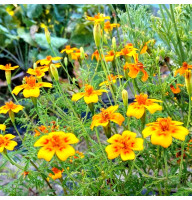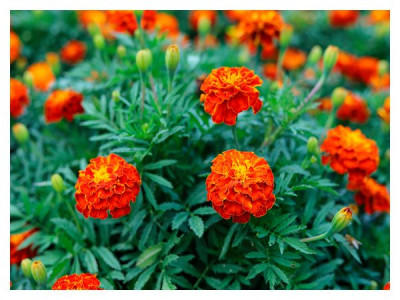Bright, sunny marigolds (Tagetes) often adorn flower beds and beds. Experienced gardeners know about the beneficial properties of these flowers and plant them throughout the site to scare away various pests and improve the land.

The medicinal properties of marigolds have been known since ancient times. The essential oil contained in the plant is a powerful natural antiseptic. Therefore, marigold inflorescences are often used in cosmetology and traditional medicine.
The strong aroma of tagetes is familiar to many gardeners. Phytoncides, which are found in all parts of this crop, help protect the beds from the onion fly, Colorado potato beetle and cabbage white. The roots of the plant secrete thiophene, which repels soil pests and also inhibits the growth of certain weeds, such as wheatgrass and horsetail. Therefore, marigolds can be planted along the edges of the beds, in wide aisles, in trunk circles. Both beautiful and useful!
Unpretentious marigolds delight us with flowering all summer, but with the onset of cold weather, the bushes fade and lose their attractiveness. How can marigolds be used after flowering?
First of all, it is worth collecting seeds from the plants you like, unless, of course, you grow varieties, not hybrids. And plant stems are planted in the ground in the beds or put in compost.
How to collect marigold seeds

Select large, healthy flowers for seeds. After the inflorescences wither, in dry and sunny weather, collect dried seed baskets. If prolonged autumn rains have begun, the branches with wilted inflorescences that you left for seeds should be cut and dried by hanging them by the stems in a well-ventilated place. When the flowers are completely dry, tear off the petals and remove the seeds. It is best to store marigold seeds in a paper bag or box in a dark and dry place.
Protecting strawberries from nematodes

Many gardeners are faced with such dangerous strawberry pests as nematode and weevil. Phytoncides secreted by marigolds repel these insects. Therefore, inflorescences, chopped stems, as well as petals and baskets left after collecting seeds, can be embedded in the ground between the rows of strawberries. And if, when planting bushes, several marigold inflorescences are placed on the bottom of each hole, protection against nematodes is guaranteed!
Marigolds for autumn plantings

All parts of marigolds: both flowers and stems - in autumn can be embedded in the ground along with green manure, burying them on a shovel bayonet. The result is an excellent fertilizer that will "work" for several years and protect the beds from phytopathogens and pests. If you are preparing a garden bed for the autumn planting of onions, garlic or carrots, then you should dig green manure and marigolds a month before.
After the winter planting of vegetables, the beds can be mulched with spruce branches and cut marigold stems. This will protect the earth from freezing, and future shoots from pests. In spring, spruce branches should be removed, and marigold stalks can be left in the aisles.
Marigold composting

Marigolds can improve the composition of the compost heap. It is advisable to chop large stems, and put a layer of other organic matter on top and add a little last year's compost. After that, everything should be poured with water. In order for plant residues to rot faster, a bioaccelerator containing beneficial bacteria, biologically active substances and enzymes can be added to the composter.
When removing marigolds from the site, you can not pull them out with roots, but simply cut off the aerial part. The root system of these plants improves the composition and structure of the soil, increases air and moisture permeability, and prevents leaching of important trace elements. And the useful substances that are secreted by the roots remain in the ground for a long time.
In addition to marigolds, there are other plants that will help to cope with diseases and pests in your area: calendula, nasturtium, chamomile, mint, hazel grouse, etc.











